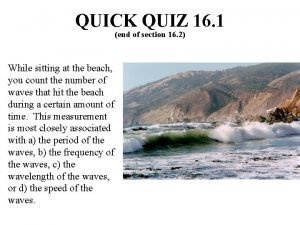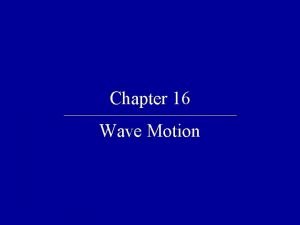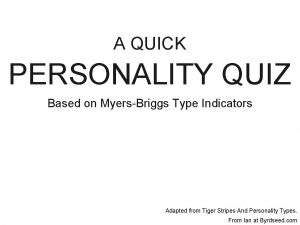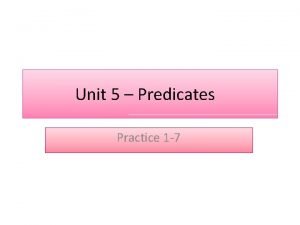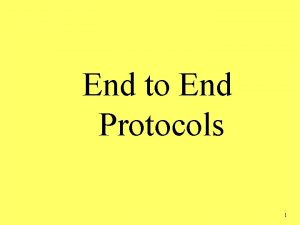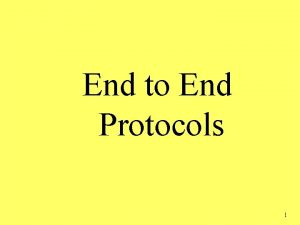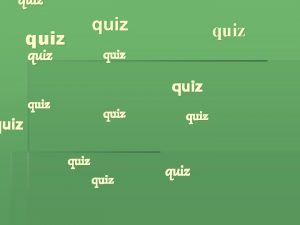QUICK QUIZ 26 1 end of section 26










- Slides: 10

QUICK QUIZ 26. 1 (end of section 26. 2) The volume enclosed by the plates of a parallel plate capacitor is given by the equation Volume = Ad. If one doubles the area, A, of the plates and reduces the plate separation, d, by a factor of two so that the volume remains the same, the capacitance will a) decrease by a factor of 4, b) decrease by a factor of 2, c) remain constant, d) increase by a factor of 2, or e) increase by a factor of 4.

QUICK QUIZ 26. 1 ANSWER (e). Because the capacitance is determined by Equation 26. 3, C = eo. A/d, doubling the plate area and decreasing the plate separation by a factor of two will increase the capacitance by a factor of 4.

QUICK QUIZ 26. 2 (end of section 26. 2) You are given a certain area of plate material to construct either a parallel plate or spherical capacitor. To maximize the capacitance, you will make the plate separation, d, as small as possible but are limited to a minimum value to avoid dielectric breakdown. Assume that the plate separation will be much less than the dimensions of the plates (e. g. d is much less than the radius of either sphere of the spherical capacitor). Also, you will use the same area of plate material and use the same plate separation for each capacitor. You will find that the capacitance of the spherical capacitor is a) significantly less than the capacitance of the parallel plate capacitor, b) about the same as the capacitance of the parallel plate capacitor, c) significantly more than the capacitance of the parallel plate capacitor, or d) impossible to compare without knowing the precise dimensions of the parallel plate and spherical capacitor.

QUICK QUIZ 26. 2 ANSWER (b). For the parallel plate capacitor, Cp = eo. A/d = A/(4 pked). For the spherical capacitor, Cs = ab/(ke(b-a)) = ab/(ked). For d << a, ab ~ a 2 ~ b 2. Using the same plate area for the spherical capacitor as the parallel plate capacitor implies, A = 4 pa 2 ~ 4 pb 2 ~ 4 pab. Therefore ab ~ A/4 p and Cs ~ A/(4 pked); identical to the formula for the parallel plate capacitor.

QUICK QUIZ 26. 3 (end of section 26. 2) As was shown in Example 26. 3, the capacitance of a spherical capacitor is given by the expression C = ab/(ke(b - a)), and in the limit that the radius of the outer spherical shell goes to infinity, the capacitance is given by C = a/ke. Assume instead that you have a spherical capacitor of plate radii a and b and, while keeping the radius of the outer spherical shell constant, you let the radius of the inner spherical shell go to zero. In this limit, the formula for the capacitance would be a) C = b/ke b) C = a/ke c) C = (b - a)/ke d) C = (b + a)/ke

QUICK QUIZ 26. 3 ANSWER (b). From the expression C = ab/(ke(b - a)), dividing top and bottom by b yields C = a/(ke(1 - a/b)). In the limit that a is much less than b, whether it is because b goes to infinity or because a goes to zero, you still wind up with the same expression, C = a/ke.

QUICK QUIZ 26. 4 (end of section 26. 3) A very large capacitor is in series with a very small capacitor. The equivalent capacitance of this combination will be a) slightly greater than the capacitance of the large capacitor, b) slightly less than the capacitance of the large capacitor, c) slightly greater than the capacitance of the small capacitor, or d) slightly less than the capacitance of the small capacitor.

QUICK QUIZ 26. 4 ANSWER (d). Using Equation 26. 10 for two capacitors in series, Since Csmall/Cbig is a small number, the denominator will be just slightly greater than 1, and the equivalent capacitance will therefore be slightly less than the capacitance of the small capacitor.

QUICK QUIZ 26. 5 (end of section 26. 5) Three of the materials from Table 26. 1 are listed below. Assume you perform an experiment where you charge up the plates of a parallel plate capacitor with a battery to a certain charge, Qo and voltage, Vo. You then remove the wires between the battery and the capacitor. You then successively place each of the three dielectric materials between the capacitor plates. In each case, the dielectric material is made to completely fill the region between the plates. The material that will be least likely to undergo dielectric breakdown will be a) neoprene rubber, b) polyvinyl chloride, c) Teflon, or d) impossible to determine without knowing the dimensions of the capacitor. Material Dielectric Constant k Dielectric Strength (106 V/m) Neoprene rubber 6. 7 12 Polyvinyl chloride 3. 4 40 Teflon 2. 1 60

QUICK QUIZ 26. 5 ANSWER (b). Dielectric breakdown occurs when the maximum electric field (dielectric strength) is reached. Therefore, you would like to choose a material with a high dielectric strength. However, since the capacitor is disconnected from the battery, the voltage will decrease by a factor of k when the dielectric is introduced. In addition, since the electric field is related to the voltage by DV = Ed, the electric field also is reduced by a factor of k. You would therefore also like to maximize k so that the electric field encountered by the material is reduced. We want the encountered electric field, E, to be less than the maximum electric field (dielectric strength), Emax. We know that E = DVo/kd and we want Emax > E or Emax > DVo/kd or k Emax > DVo/d. Therefore, we would like to maximize the product k Emax and this is a maximum for polyvinyl chloride.
 Section quick check chapter 10 section 1 meiosis answer key
Section quick check chapter 10 section 1 meiosis answer key Quick find vs quick union
Quick find vs quick union 1.7.6 - quick check: frost quick check
1.7.6 - quick check: frost quick check Quick quiz 16 answers
Quick quiz 16 answers Quick quiz 16 answers
Quick quiz 16 answers Quick personality quiz
Quick personality quiz Predicate and predicator
Predicate and predicator Stroke volume
Stroke volume End diastolic volume meaning
End diastolic volume meaning Compiler front end and back end
Compiler front end and back end What is front end and back end of compiler
What is front end and back end of compiler



